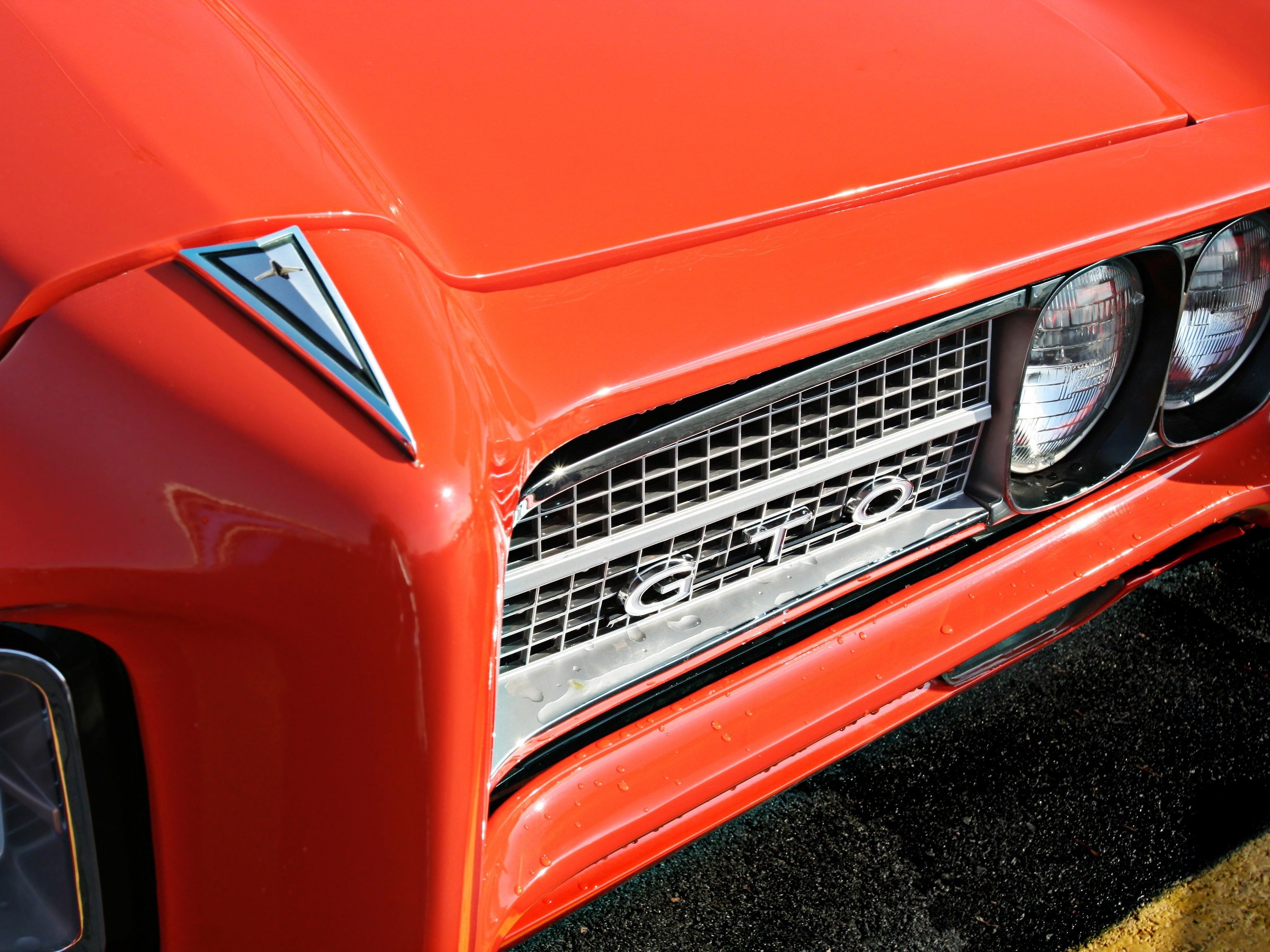
The world of classic car ownership is plagued by two opposing mandates that have discouraged many a collector over the years. The first is a desire to keep the vehicle as original as possible. The second is to actually be able to start and drive the thing, which usually entails aftermarket auto parts replacement and upgrades of one kind or another. The key, of course, is striking an acceptable balance between these two extremes–a balance that you, the owner, can live with, as well as one that will not adversely affect the car’s ultimate value.
Let’s face it. The older and more rare a classic car is, the more likely it is to require non-factory classic car parts. If you own a 1969 Pontiac GTO you may still be able to find factory-made or factory-remanufactured parts, but if you have a 1954 Kaiser Darrin, every part you require will, by definition, be in the category of aftermarket parts if not specifically custom-machined.
One strategy that’s increasingly popular is to replace the wheels and tires for practical road use, but reverting to the originals at car shows. This saves possible wear and tear on the valuable original equipment.
Other owners sidestep the issue entirely by ignoring the first mandate and fully accepting any and all classic car parts. They modify their cars without a second thought for originality, opting for the pleasures of today in place of the authenticity of the past. There is certainly nothing wrong with this approach as long as you are not talking about a Duesenberg or Hispano-Suiza. Then again, you wouldn’t be taking either of those on an extended road trip that might demand more modern creature comforts.
If you’re not a stickler for original parts, there are all kinds of things you can do to older cars to make them more suitable (and practical) for road use. Over and above aftermarket auto parts, there are always car accessories and gadgets that were never dreamed of when some of the older models were created. These include everything from cosmetic changes to air conditioning, car audio, and MP3 players.
In the end, after all, it is your car. If you’re not overly concerned about its resale value and want to enjoy your ride now, then all changes are fair game. Like all car care and repair decisions, it’s your call.
How well do you know your classic cars? Take our trivia challenge!

Cars are no longer just a solution to take us from point A to point B. In today’s world, where we’re more connected to our homes, families, work and friends, our vehicles are also keeping up with advancing technologies. The modern car can help (literally!) steer us down the right path.
An array of smart and interactive car accessories are transforming the way we drive. Here’s what could very likely come standard in the next vehicle you buy:
1. Smart safety features.
Proximity sensors to warn you of hazards ahead on the road, automatic-braking, and park assist are just a few of the technological advancements being included in new vehicles.
2. Smart vehicle maintenance information.
Digital messages can let you know about looming maintenance issues like worn brake pads, a brake light that is about to burn out, or other problems well beyond what most current vehicles can “sense.”
3. Location information.
Based on your specific location, your car will be able to provide suggestions for local restaurants, attractions and hotels in the area.
4. Communication.
You will be able to connect to other devices, including other cars, phones, computers, home appliances and thermostats.
5. Data tracking.
Information about vehicle speed, usage and driving habits will be collected by your vehicle. Among the uses for this information are usage-based insurance policies which set premiums based on driving behaviour.
While our cars might be able to do more for us, what will it mean for our privacy? Vehicles are increasingly capable of transmitting information wirelessly, leading to questions about privacy and security.
Many manufacturers are planning to collect this information, but the Canadian Automobile Association (CAA) believes that as the driver, you should have the ability to control what information is shared and where it goes. Among other things, the CAA recommends that vehicles should be built with a clear menu so consumers can opt-in to share the information they want to with the automaker or other service provider, such as a garage.
While some of these technologies may seem futuristic, there are currently data-collecting capabilities that car vendors use every time a car is serviced. Vehicles have been collecting limited repair data for years. The big change ahead is that much more information will be collected, and that information will be capable of being transmitted wirelessly to your vehicle manufacturer.

An ounce of prevention is worth a pound of cure, and this is especially true when it comes to the major investment we make in our cars.
“Winter is harsh on automobiles with deep-freeze temperatures, slippery conditions, plus stop-and-go gear changing,” says Colin Dilley at Prestone, a leading name in engine protection products.
Here, Dilley gives us a few quick and easy winter maintenance tips:
• Top up windshield fluids with a winter-specific formula and replace windshield wiper blades if brittle.
• Check tire pressure regularly and top up the air as recommended.
• Check the treads on your tires and, for the best vehicle control, replace them no later than 5/32″ of remaining tread depth.
• Top up the antifreeze/coolant with a formula guaranteed to protect against corrosion. Corrosion can cause engines to quickly overheat, even in the winter. With the rigours of winter conditions, be sure to top up or do a complete flush and fill with an antifreeze/coolant that contains a proven corrosion inhibitor. A key feature in Prestone antifreeze/coolant is the corrosion inhibitor package that’s guaranteed to work in all domestic, Asian, and European autos. It ensures compatibility with the antifreeze/coolant requirements in any car.
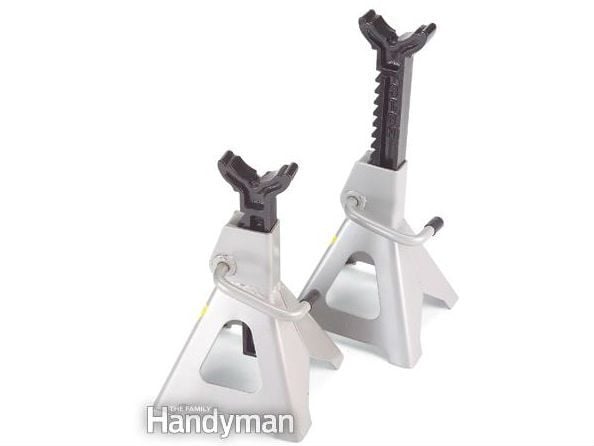
Think it’s safe to crawl under your vehicle while it’s resting on a car jack? Think again. You don’t have to spend a fortune on the right equipment to protect your life and make the job easier. But you do have to know what to look for. We’ll spell it all out for you.
Floor jacks for the do-it-yourselfer come in two price ranges: economy ($30 to $40) and semi-pro ($65 to $99). We don’t recommend the economy jacks, even for occasional use. They have a short wheelbase, a narrow width, an extremely small “saddle” (the part the car rests on), poor stability and a low lifting capacity. Their short pump handle forces you to crawl under the vehicle just to place it in the right position for jacking.
For about $35 more, you can buy a 3-1/2-ton semi-pro jack. You’ll get a wider, more stable wheelbase, heavy-duty wheels, a higher lift (22 in. vs. about 15 in. on the low-priced models) and a nice, long pump handle. The long pump handle allows you to place it under an engine cradle or differential without crawling under the vehicle. It’ll take up more garage space, but the additional features are worth it.
Jack stands also come in two styles: a pin lock with three legs and a ratchet lock with four legs. The ratchet style is much easier to use and usually supports more weight, while the four-leg base provides more stability.
Check your car’s owner’s manual to locate the recommended jack support locations. Don’t crawl under any car supported only by the floor jack. Always use at least two jack stands and lower the weight of the vehicle onto the stands.
Check out more do-it-yourself car maintenance tips!
Explore Reader’s Digest Cars.
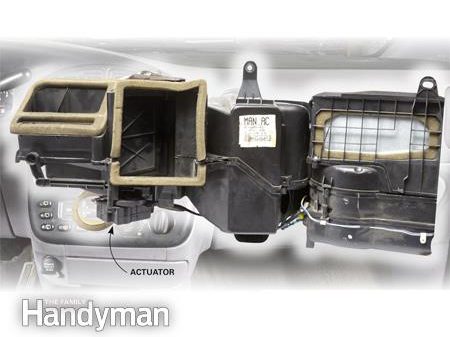
Most late-model cars use electric motors (called actuators) to change the air temperature and direction of the airflow by opening and closing flaps in the heater box under the dash. If your battery has gone dead, or you’ve disconnected it to work on your vehicle and now you can’t change the air temperature, you probably just need to perform a recalibration.
Find the procedure in a shop manual (at auto parts stores for about $20). But if you’re still not getting any heat and you’ve checked both heater core hoses to make sure they’re hot, you likely have a bum actuator. You can usually diagnose and fix the problem yourself in about an hour. A new actuator costs less than $100. All you need is a shop manual, a 1/4-in.-drive socket set and screwdrivers.
Consult the repair manual to identify which actuators control the defrost-vent-floor “mode door” and the temperature-regulating “blend door.” Then peer under the dash and locate the suspect actuator on the heater box (image above). Have a friend switch between modes or temperatures while you watch the actuator. If the actuator doesn’t move, it’s probably bad.
There’s a chance the mode or blend door actuator may be good but the door or linkage is binding, so check it before you replace the actuator. If the door binds, take it to a pro for replacement. However, if it moves smoothly, buy a new actuator from the dealer or auto parts store. Install it and test the operation. In some cases, you’ll have to perform a calibration.
Check out more do-it-yourself car maintenance tips!
Explore Reader’s Digest Cars.
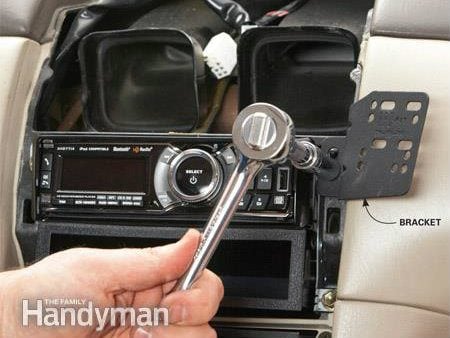
Want a great way to mount your mobile tech in your car without drilling holes in your dashboard? How about a vehicle-specific bracket/adapter mounting system? You can buy a version for just about any car or device from pro-fit-intl.com. The mounting bracket for this 1999 Toyota Camry fits onto one of the radio fasteners. Other versions mount in different places. Then the device-specific adapter mounts to it.
Tools and materials required for this project:
– Mounting bracket
– Adapter for electronic device
Step 1: Attach the bracket to the radio.
Remove the trim bezel and one of the bolts that hold the radio in place. Then attach the bracket and reassemble.
Step 2: Install the device-specific adapter.
Connect the adapter to the dash bracket. Then slide your GPS or cell phone into the adapter.
Check out more do-it-yourself car maintenance tips!
Explore Reader’s Digest Cars.
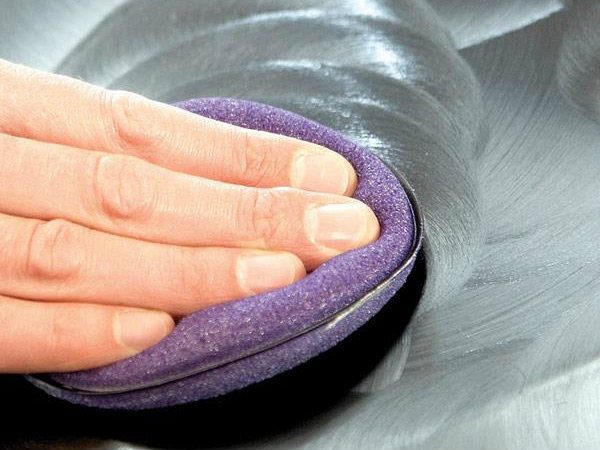
When buying a new car, you might wonder whether or not to have the dealer apply a sealant for $300-$400. Paint sealant really is a good product. But it’s nowhere near as perfect as the dealer would like you to believe. If you read the fine print on the “lifetime” guarantee, you’ll see that you have to bring the vehicle back for repeat applications on your dime. With routine reapplications, the paint sealant sounds more and more like, uh, car wax.
In fact, paint sealant is nothing more than a polymer-based car “wax” that seals better and lasts longer than traditional carnauba-based waxes. You can apply the same finish yourself for about $20 (try Meguiar’s NXT Generation Tech Wax 2.0, or Klasse High Gloss Sealant Glaze). Or, you can find an auto detailer shop that’ll apply it for about $90.
Apply paint sealant yourself and save big bucks:
Tools and materials required for this project:
– Paint sealant
– Microfibre towel
Directions:
Pour the sealant onto a foam application and spread it around. Wipe off the excess with a microfibre towel.
Check out more do-it-yourself car maintenance tips!
Explore Reader’s Digest Canada.

- Decide on the fireplace’s main purpose.
Is it heat-efficiency, aesthetics or a combination of both? By communicating this information to the fireplace sales person, your options will narrow and your selection process will become much easier. - Don’t buy a fireplace with the intention of heating more than one room.
Trying to save on heating costs in this way will result in an overheated main room, forcing you to keep the gas fireplace off much of the time. - If you’re looking for heating efficiency, consider a thermostat-controlled, self-modulated fireplace.
This way, the fireplace will automatically turn up and down while regulating the room to the temperature you desire. - Research the fireplace trim options to determine which would best suit your décor.
Once you’ve decided on a specific fireplace insert, ask the sales person to review the trim designs that are available. Often the brochure will feature options not seen in the showroom, and you’ll surely find something that blends seamlessly with your existing decorating style. - View the fireplace while the flames are inactive-not just when they are turned on.
Since the fireplace won’t be running 24 hours a day all year long, it’s important that you are sure you like how the unit looks when it’s not fired up. - Avoid choosing a heating insert that relies on a fan to push the hot air out into the room.
The best fireplaces are efficient without a fan. Using one does help with circulation, but will only marginally improve the heat output and there will always be some noise. If you do have a fan, make sure you have a separate control for it so you can turn it up, down, or off, as needed. - When choosing a decorative log set, choose one that easily fits into the fireplace area and leaves some breathing room.
Having ample space around the log set looks better and ensures that the valve will not overheat. - Determine how you want to operate your gas fireplace.
There are a number of options available, including wall switches, remote controls and thermostats. You can also operate many fireplaces manually. - If a gas fireplace is not an option, consider an electric fireplace.
Electric fireplaces are now available in a variety of sizes and styles with lots of different trim options. They require no venting, so you can install them anywhere in the home. - Find a fireplace retailer who will arrange to have a licensed and insured HVAC contractor take care of the installation.
How the fireplace is installed can impact its overall efficiency operation and durability.

For more advice on fireplaces, visit Casa Guru-The smartest way to find licensed and insured house experts-from home stagers to contractors to home inspectors.
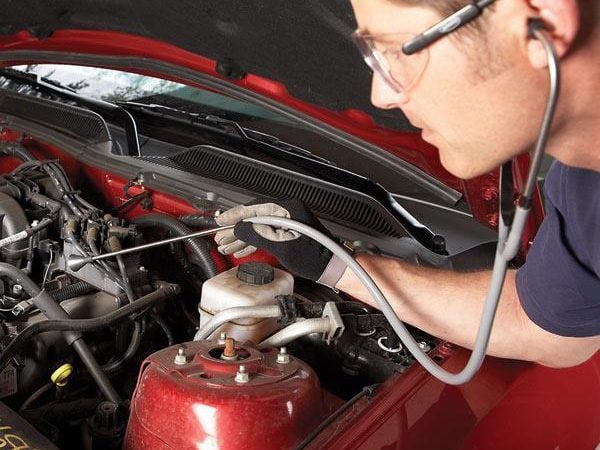
If you want to be a real car doctor, you’ve got to use the right tools. An automotive stethoscope can be the most effective diagnostic tool in your toolbox. It works just like the ones doctors use, allowing you to “hear inside” a mechanical component. The stethoscope we chose comes with two attachments: A metal probe and a sound amplifier.
– Use the amplifier to narrow down the source of the noise.
– Next, switch to the metal probe to locate the exact source of the problem. Connect the amplifier attachment to the hose and move it around the engine compartment. That will narrow your search to a smaller area. Touch the scope’s metal probe to the non-rotating part of the suspect component. If it’s worn, you’ll hear an unmistakable metallic sound.
Check out more do-it-yourself car maintenance tips!
Explore Reader’s Digest Cars.

You’ve had an eventful few years. You were a contestant on Britain’s Got Talent and you launched your career overseas with a TV special and tour in the United Kingdom. How did you realize magic was your calling?
Back when I was seven or eight, growing up in Winnipeg, my dad [famed Manitoba sportscaster Scott Oake] showed me a trick where he picked a card I’d chosen out of a deck. I was flabbergasted. For weeks he wouldn’t tell me how he’d done it, but I finally wore him down: it was an accident, a one-in-52 chance. So a fluke got me hooked on magic.
You were competing in international magic competitions by the age of 16. What was it like to grow up in that world?
I used to go to monthly meet-ups as a teen during the early 2000s. You’re probably hoping I’ll say we gathered in, like, some dark old church. But no, we met in a community-centre room to mingle and talk shop. Older magic guys would lend me VHS tapes to learn from. Mentorship has been important to me since then. When I see someone trying to learn, I go out of my way to help.
What about your peers? Did you ever get flak for being “that magic kid”?
I went through a phase in junior high and high school when I didn’t want to tell anyone I was trying to be a magician because I knew people would think I was a weirdo. But even then I believed it had the power to be really, really cool.
The stereotypical magician can be pretty cheesy.
I’ve never understood magicians who go up there in top hats and tailcoats and sequined jackets. Like, it’s 2015. Nobody dresses like that.
One of your most famous tricks involves doves. What are the hazards of working with birds? Poop? Feathers?
That’s only the start of it! One time I had a dove fly into the audience, land in a lady’s lap, lay an egg and then fly back to the stage. And I was like, Oookay. I couldn’t do that on purpose if I wanted to.
Is it difficult to keep trade secrets from your nearest and dearest?
A lot of the time it’s hard because I find the way a trick works just as cool as the actual result. It’s unfortunate I can’t tell anybody about the process. But that’s the price you pay. A magician never reveals his secrets.
Why is magic so compelling even after we supposedly become old enough to know better?
The answer is in the question. We think we know how everything works, and if we don’t know, Google will tell us. But magic, when done correctly, allows you to connect with a person and show them something impossible they can’t explain. It’s a powerful thing.
Some of your stunts seem incredibly dangerous, like hanging upside down inside a bear trap. What’s it like to put yourself in peril?
It’s a funny mind space. Part of me is like, “This is stupid. I don’t know why I’m doing it.” Another part is like, “This is going to be fantastic if it works.” And a third part is like, “If this goes horribly wrong, at least I’ll go out like a legend.”
Darcy Oake is currently on tour. Click here for dates!